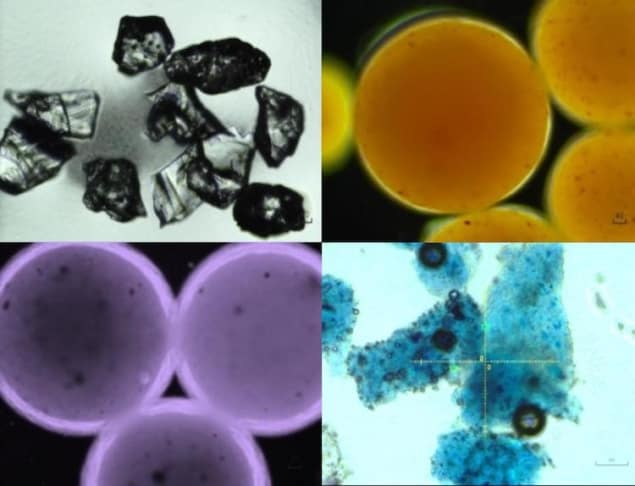
Microplastic pollution is becoming a serious problem worldwide and is dangerous for both aquatic life and human health. Few solutions to treat this problem currently exist, but researchers in Australia have now developed an environmentally friendly technique for removing these contaminants from water sources using carbon nanosprings. The nanomaterials are benign to aquatic microorganisms, they say, and may even be harnessed as a hydrocarbon source for cultivating algae, so allowing these plastics to be reused in a positive way.
Microplastics are a subgroup of plastics and are defined as those that measure less than 5 mm across. They can be further classed into primary and secondary microplastics and mostly originate from everyday cosmetic products (exfoliating facial creams and the like) and the breakdown of large pieces of plastics from household rubbish.
Microplastics are now unfortunately ubiquitous in aquatic systems and are difficult to recycle or remove by conventional wastewater purification techniques because of their small size. These microcontaminants take decades to break down naturally. More worrying still, since they adsorb hydrophobic organic pollutants and heavy metal contaminants in water, they accumulate these hazardous substances over time and end up poisoning marine life. And when ingested, they accumulate all the way up the food chain, explains study co-leader Shaobin Wang, who is at Curtin University in Perth and the University of Adelaide.
Reactive oxygen species break down organic pollutants in water
Researchers recently discovered that reactive oxygen species (ROS) can break down organic pollutants in water. In these studies, however, the ROS were produced using heavy toxic metals such as iron or cobalt, which bring their own share of problems.
Wang and colleagues have now found a way around this problem by producing ROS using manganese carbide nanocomposites encapsulated in helical-shaped carbon nanotubes doped with nitrogen. They made these nanomaterials using a one-pot pyrolysis technique.
The researchers tested out their nanocomposites on various plastic-containing solutions including one containing microplastic beads from a commercial facial cleanser. They found that the carbon nanotube catalysts removed a significant fraction of these plastics in solution in just eight hours while remaining stable themselves. The catalysts do this by shearing the long-chain molecules in the microplastics into sub-polymers with shorter carbon chains. These sub-polymers are then attacked by the ROS and broken into short chains with a lower molecular weight. These short chains are harmless and dissolve in water.
Great mechanical strength and ultrahigh chemical stability
“The fascinating thing about our catalyst design is that we can control the morphology and structure of the nanocarbon material by the pyrolysis temperature,” explains study co-leader Xiaoguang Duan, who is at Adelaide. “In this way, we can transform them into carbon clusters, long/short carbon nanotubes and spring-like structures. The nanosprings are particularly interesting since they have great mechanical strength and ultrahigh chemical stability in the oxidizing conditions that exist during microplastic degradation.
“Their coiled shape also makes them stable and maximizes the surface area of the catalyst.”
The fact that they contain manganese makes them magnetic too, which means that they can be easily separated and recycled from wastewater streams once their job is done, so that they can be used again and again, he adds. And since the manganese is embedded deep in the nanosprings, it cannot leach out easily, which means it will not cause any secondary contamination.
Degradation intermediates are non-toxic
To make sure that the intermediates produced from microplastic degradation were not more polluting than the microplastics they are meant to treat, Wang, Duan and co-workers analysed how green algae (Chlorella vulgaris) fared in the reaction filtrate. They found that the intermediates had little effect on the algae.
There was another pleasant surprise in store for the researchers: after six and eight hours in the reactor, they observed that the optical densities of the algae increased by 8% and 12% respectively when compared to controls in pure water. According to the team, this implies that the lightweight-molecule by-products from microplastic degradation might actually be harnessed as hydrocarbon sources for growing algae.

Plastic particles now infest the Arctic
Towards a new technology for controlling and re-utilizing plastics?
The organic intermediates from microplastics might be digested by microorganisms to be transformed to other valuable products (such as sugars, proteins and biofuels), so returning the carbons to nature, says Duan. Alternatively, these products might be reused by us humans in a green and sustainable way. “This may provide us with a new opportunity for coupling catalytic oxidation with biotechnology for controlling and re-utilizing plastics.”
The researchers now plan to develop more advanced strategies to degrade microplastic of different compositions and structures that they will collect from rivers and oceans as well as sediment. “We will also be looking to improve the performance of our nanocarbon catalysts and the reaction conditions in which they work,” Duan tells Physics World. “We will systematically investigate the degradation pathways of microplastics by the free radicals and further evaluate the toxicity of the organic intermediates at every stage of the breakdown process.”
The research is detailed in Matter 10.1016/j.matt.2019.06.004.



